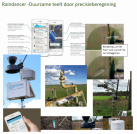No crops without water
During the growing season, the plants must be able to absorb enough water daily to ensure good crop development. In open field cultivation, availability is largely dependent on the weather. If the plots on which the crops are located are too dry, the farmer can sprinkle. For this, the farmer can pump water from the surface water or from the groundwater.
The fact that there are limits to this was demonstrated (again) during the long dry period in the summer of 2018. It resulted in significant damage to Brabant's nature and a strong reduction in yields of crops, including potatoes, onions, corn and fruit. The summer of 2018 shows that measures are needed to combat salinization and ensure better water management.
The province of Noord-Brabant has organized various measures and information campaigns for better water management with the agricultural organization ZLTO and the water boards. Under the 'Well watering' scheme, the province of Noord-Brabant makes a financial contribution to investments by Brabant farmers in water conservation measures and measures to improve soil retention.
Irrigation is sometimes necessary, but why does the farmer not know how much water has been applied during a turn?
Van den Borne Potatoes has invested in several of the measures, such as permanent tramlines, water storage on site and soil improvement by increasing organic matter content.
Plans are also being developed for investment in level-controlled drainage. Like every farmer, we look at which measures are technically and economically feasible for the plots. Even with the measures taken, it is not possible to prevent periods when irrigation is necessary. The irrigation systems available on the market are available in fixed and variable configurations with sprinklers with adjustable angle and circle. With the advent of computer-controlled reels and reels, deployability has further increased.
The modern irrigation pump has a protection so that it shuts off when no water is pumped up. The pressure is not registered further. The sprinkler systems do not measure how high the water pressure at the sprinkler is. Variations in water pressure are also not measured. Leaks in pipes or hoses are only detected during an inspection. The conclusion is therefore justified that the farmer does not know at the end of the watering how many millimeters of water he has brought on his plot. That is still outside normal practice that due to a break in the pipe or hose, failure of the sprinkler system or pump or loss of water pressure, parts of the plot are not irrigated at all.
Irrigation pumps without greenhouse gas emissions. In the draft climate agreement it has been proposed to focus on “innovations for the reduction of greenhouse gas emissions in the production of food and non-food 2050”. The target and ambition for 2030 mentioned by the government is to achieve an additional decrease of 3.5 Mton greenhouse gas emissions in 2030. In addition, efforts are being made to “reduce greenhouse gas emissions from agricultural vehicles”. The sprinkler system uses diesel engines to pump up the water and thus does not contribute to the objectives of the climate agreement






Social media
Bezoekers online: 18